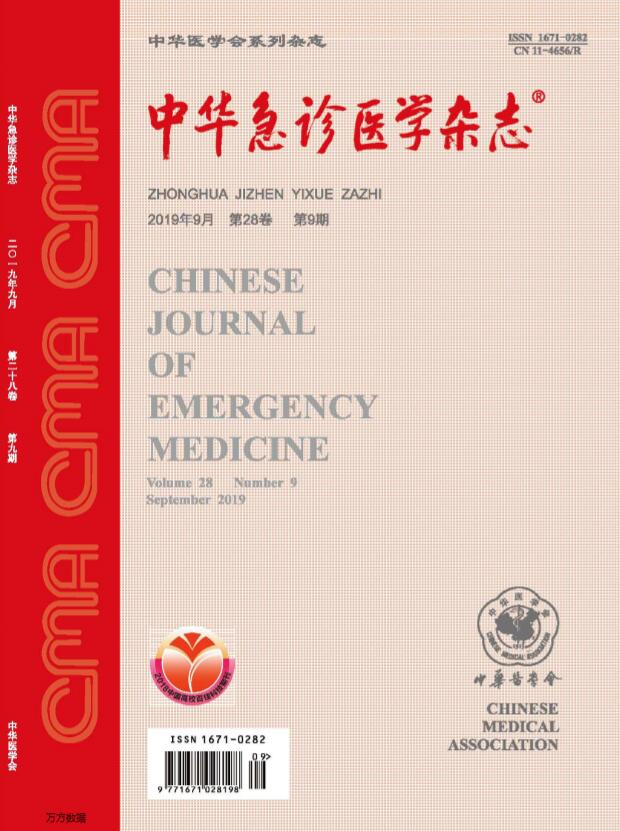急救人员电话心肺复苏认知调查
Q4 Nursing
引用次数: 1
摘要
目的了解急救医疗系统(EMS)工作人员对调度员电话心肺复苏(TCPR)的认知情况,比较不同经济状况下EMS工作人员对TCPR的认知,了解我国EMS工作人员TCPR认知现状。方法本研究为多中心横断面调查。采用多层次方便抽样的方法,对问卷的测试信度和分半信度进行了检验。问卷调查和数据收集于2018年12月至2019年6月进行。伦理批准号为M2018264。采用SPSS 20.0进行分析。采用χ2检验分析各组间的差异。结果共收集电子问卷1191份。其中,80.94%的受访者知道TCPR,97.82%的受访者认为心脏骤停时应实施TCPR,36.62%的受访者认为TCPR中需要旁观者心肺复苏质量监测,急诊科开设了TCPR培训课程,招募了25.83%的受访者。发达地区的急救人员对判断患者呼吸困难的标准有更好的理解(11.69%对7.89%,P=0.048),TCPR需要包括胸部按压指导(92.45%vs.87.49%,P=0.012)和旁观者心肺复苏(BCPR)质量监测(包括人工呼吸频率)(84.42%vs.74.87%,P=0.029)的比率高于欠发达地区,但其他指标差异无统计学意义(P>0.05)。需要进一步培训,以提高他们对通过电话、TCPR内容和旁观者心肺复苏质量监测判断院外心脏骤停患者心脏骤停的标准的理解。我国经济发达地区和欠发达地区EMS人员在TCPR知识方面存在差异。关键词:紧急医疗服务;电话指导;心肺复苏;旁观者;院外心脏骤停;认知;经济状况;横断面调查本文章由计算机程序翻译,如有差异,请以英文原文为准。
Cognitive survey of telephone cardiopulmonary resuscitation among emergency personnel
Objectives
To investigate the cognition of dispatcher-initiated telephone cardiopulmonary resuscitation (TCPR) among emergency medical system(EMS) personnel and compare the cognition of TCPR among EMS personnel in different economic status, and to understand the current situation of TCPR cognition of EMS personnel in China.
Methods
This study is a multicenter cross-sectional survey. The method of multi-level convenient sampling was adopted, and the test reliability and split half reliability of the questionnaire was tested. Questionnaire survey and data collection were conducted from December 2018 to June 2019. The ethical approval number is M2018264. SPSS 20.0 was used for analysis. χ2 test was used to analyze the differences between groups.
Results
A total of 1 191 electronic questionnaires were collected. Of them, 80.94% respondents knew TCPR, 97.82% respondents thought that TCPR should be implemented in cardiac arrest, 36.62% respondents thought that bystander cardiopulmonary resuscitation quality monitoring was needed in TCPR, and TCPR training courses were set up in the emergency department which recruited 25.83% respondents. Emergency personnel in developed areas had a better understanding of the criteria for judging patients' breathlessness (11.69% vs 7.89%, P=0.048), of TCPR need ncluding guidance of chest compression (92.45% vs 87.49%, P=0.012) and of bystander cardiopulmonary resuscitation (BCPR) quality monitoring including the frequency of artificial respiration (84.42% vs 74.87%, P=0.029) than those in underdeveloped areas, but there was no significant difference in other indicators (P>0.05).
Conclusions
TCPR knowledge of EMS personnel in China is unsatisfactory. Further training is needed to improve their understanding of the criteria for judging cardiac arrest in out-of-hospital cardiac arrest patients via telephone, TCPR content and bystander cardiopulmonary resuscitation quality monitoring. There is difference in TCPR knowledge between the EMS personnel in developed and undeveloped areas in China.
Key words:
Emergency medical services; Telephone guidance; Cardiopulmonary resuscitation; Bystander; Out-of-hospital cardiac arrest; Cognition; Economic status; Cross-sectional survey
求助全文
通过发布文献求助,成功后即可免费获取论文全文。
去求助
来源期刊

中华急诊医学杂志
Nursing-Emergency Nursing
CiteScore
0.10
自引率
0.00%
发文量
8629
期刊介绍:
Chinese Journal of Emergency Medicine is the only national journal which represents the development of emergency medicine in China. The journal is supervised by China Association of Science and Technology, sponsored by Chinese Medical Association, and co-sponsored by Zhejiang University. The journal publishes original research articles dealing with all aspects of clinical practice and research in emergency medicine. The columns include Pre-Hospital Rescue, Emergency Care, Trauma, Resuscitation, Poisoning, Disaster Medicine, Continuing Education, etc. It has a wide coverage in China, and builds up communication with Hong Kong, Macao, Taiwan and international emergency medicine circles.
 求助内容:
求助内容: 应助结果提醒方式:
应助结果提醒方式:


